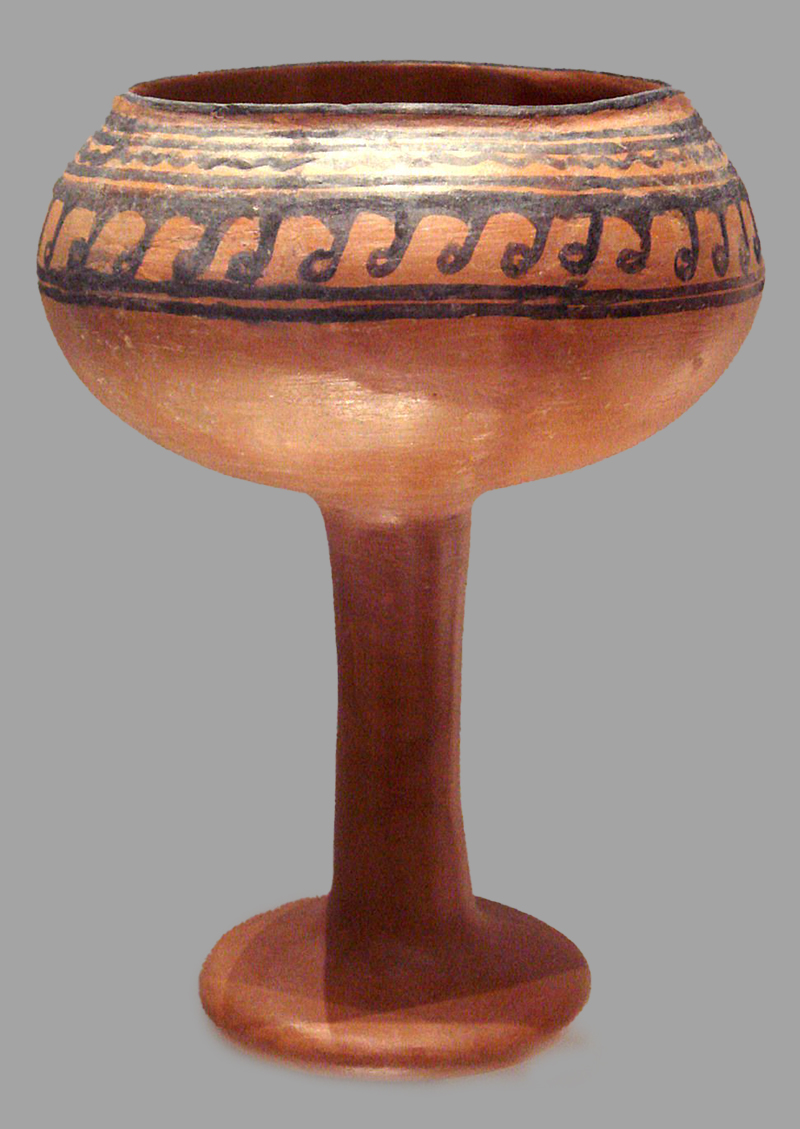Dated to the second millennium BCE in the Chalcolithic period, the Malwa Culture is a post-Harappan culture identified by its distinct type of painted pottery. The culture extended over the Deccan region, corresponding to parts of present-day central Maharashtra and Madhya Pradesh and derives its name from the Malwa region in Madhya Pradesh, in India.
The culture has been dated to between 2000 and 1400 BCE in the Malwa region, and between 1800 and 1400 BCE in Maharashtra. In the northern Deccan region, Malwa Culture succeeded the Neolithic-period Savalda Culture, while in central India, it succeeded the Kayatha Culture and, at some sites, the Ahar Culture. Geographically, the Malwa Culture extended from Inamgaon in present-day central Maharashtra to Navdatoli in Madhya Pradesh. Other important sites include Maheshwar and Mandasor in Madhya Pradesh and Prakash and Daimabad in Maharashtra.
The Malwa Culture is known for its distinct pottery styles, comprising wheel-made black-on-red ware, coarse red ware and red/grey ware, of which the black-on-red ware — also known as black-painted red ware — was most prolific. The fabric of the pottery ranged from coarse, with pieces of chopped husk in the core, to fine (predominantly in Maharashtra). The types of objects made include a utensil resembling a lota, with a wide flaring mouth and bulbous base with carination or ridges on the body, a channel-spouted bowl, deep bowls with carination, a spouted vessel with a flaring mouth distinct to Maharashtra, globular jars, deep bowls, knobbed lids and basins. Navdatoli is the only site where goblets or drinking chalices were found.
The upper part of the pottery artefacts are decorated with paintings rendered in black pigment. The paintings are usually highly stylised depictions that include geometric designs such as linear patterns, triangles, lozenges and diamonds, along with depictions of animals including black buck, bull, dog, deer, peacock, pig, tiger, panther, fox, tortoise, crocodile and insects. Depictions of human figures are rare. Altogether, there are estimated to be over six hundred painted motifs.
Painted and decorated pottery are believed to have had religious significance. For example, a jar decorated with applique figures of a female worshipper and a lizard flanking a shrine-like structure was found at Navdatoli. The shrine-like structure is decorated with a tortoise. The tortoise motif is also seen on an amulet found at Prakash, leading scholars to suggest a degree of religious significance. A painting on a fragment of a channel-spouted bowl from Navdatoli depicts a standing human figure with dishevelled hair, which some scholars have identified as a proto-Rudra, while a male figure surrounded by animals on a jar from Daimabad has drawn comparisons with Pashupati. The Daimabad bronze figurines, which date to the Late Harappan phase, have also been ascribed with ritual significance. The presence of bull figurines at some sites may indicate worship of the bull and nature deities. Remains of fire altars have also been found at Daimabad, Inamgaon and Navdatoli. Evidence of an apsidal structure, believed to be a sacrificial temple, was also found at Daimabad.
Other structural remains included circular or rectangular houses and chulhas or hearths. The site of Eran was also marked by a large fortification wall and moat — a singular find of the Malwa Culture. Stone tools were dominant in Navdatoli, and the finds from the settlement indicate that each home made its own tools; the stone tools include knives and blades, and copper tools include flat celts, chisels, arrowheads, swords and ornaments. Evidence of urn burials for children was also found at Inamgaon.
Scholars have remarked on the parallels between some of the pottery and metal artefacts found at Malwa Culture sites with similar objects in western Asia. For instance, the design of channel-spouted bowls is similar to West Asian finds, as is a mid-ribbed sword found in Daimabad. However, these objects appear in the archaeological record before those of the Malwa Culture, and it is therefore unclear how the forms came to be seen in Malwa. This has also led to speculations over the identity of the people of the Malwa Culture, with some scholars attributing the artefacts to Bhil and other communities of central India or to possible migrations from western Asia.
The Malwa Culture came to an end around 1400 BCE. In central India, the pottery phase was replaced by Black and Red Ware while in Maharashtra, it was succeeded by the Jorwe Culture.







